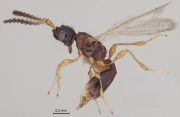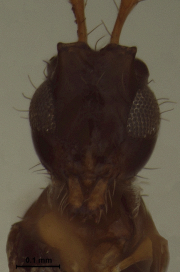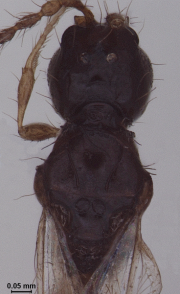 Fig 1. Body profile |
 Fig 2. Head, front view |
 Fig 3. Head, profile |
 Fig 4. Head and mesosoma, dorsal view |
 Fig 5. Antenna (female) |
 Fig 6. Antenna (male) |
|
 Fig 7. Forewing |
 Fig 8. Mesosoma, dorsal view |
 Fig 9. Metasoma (female) |
 Fig 10. Distribution map |
|
Nomenclature
Calogalesus Kieffer, 1912: 6, 43. Type species: Calogalesus parvulus Kieffer.
Diagnosis
About 1mm long, delicate forms. Head and body pale yellowish brown, with appendages much lighter in colour, body smooth and shining, lacking micropilosity, with sparse long semierect hairs, post gena and petiole without foam-like scaly structures. Hairy cushions on postgena, sides of pronotum and upper part of propleuron distinct, though sparse.
Head nasiform, with ridge/ ledge dorsally. Antennal shelf projecting, highly raised and with a trough-like concavity at its median. Antennae 12-segmented in females, 14-segmented in males. Female antennae not abruptly clavate, but with terminal antennal segments incrassate; except apical clavomere, rest of claval segments subglobular. Antennae clothed with irregularly scattered long and short pubescence. Male antenna elongate, filiform, A3 subequal in length to A4, A3 to A13 subglobular, A4 not modified, slightly emarginate, often carinate. Eyes with ommatidia distinct, with scattered pilosity, as long as those on frons. Malar space and temples longer than eye length. Occipital flange narrow and with fine crenuale. Mouthparts protruding beak-like, mandibles opisthognathous, feebly bidentate.
Cervix distinct. Pronotal shoulders rounded at sides, not angulate. Notauli curved and diverging in front, not dilated posteriorly and not touching transscutal sulcus. Humeral sulcus very narrow, but distinct. Anterior scutellar pit bifoveate. Lateral and posterior scutellar pits much reduced. Sternaulus indicated. Dorsellum with three keels medially. Propodeum with irregular sculpture. Longitudinal keels on propodeum indistinct. Posterolateral corners of propodeum projecting. Metapleuron richly sculptured, sparsely hairy. Nucha indicated.
Wings well developed. Venation complete, extending to nearly half of forewing length, submarginal vein remote from margin of forewing. Marginal vein extremely long, nearly twice as long as elongate stigmal vein. Postmarginal absent. Basal vein not indicated. Forewing disc medially/submedially with one or two white hairless streaks. Marginal cilia on forewings developed remarkably, as long as nearly one-third forewing width. Hindwings with submarginal vein complete.
Petiole always longer than wide, tubular, curved in profile, almost bare and usually with irregular longitudinal striae. Distinctly angulate between petiole and T2. Metasoma elongate and narrow, never as wide as mesosoma. Anterior margin of T2/large segment elevated above level of petiole, feebly concave, but without a furrow or emargination. Metasoma of female drawn into a point basally, while that of males blunt towards tip.
Geographic Distribution
For the distribution of the genus in India, see Fig.10.
Species known from India
1. Calogalesus malabaricus Rajmohana & Narendran
Remarks
Not very common in collections. A delicate body, highly raised antennal shelf, beak-like mandibles, 12-segmented antennae without an abrupt clava in females, male antennae 14-segmented, distinctly curving notauli, anterior scutellum with two pits, a bent or curved petiole, placed at an angle with T2, elongate marginal and stigmal veins of forewings, well developed marginal cilia and a narrow metasoma render this genus quite unique among Diapriinae.
The genus is known only from African, Oriental and Australian realms (Masner and Garcia, 2002).
References
|